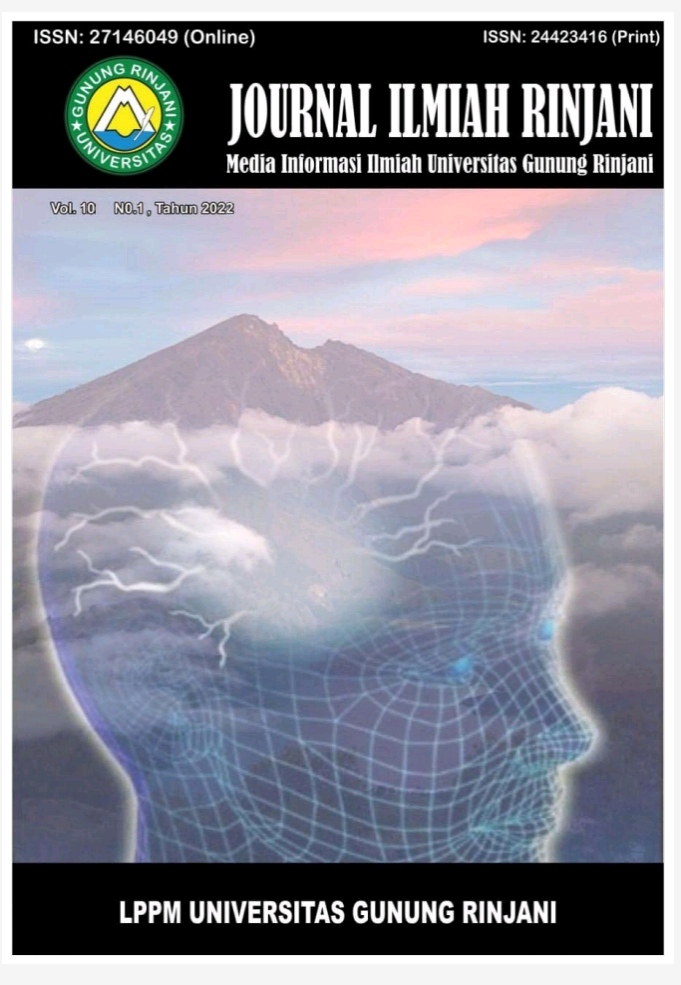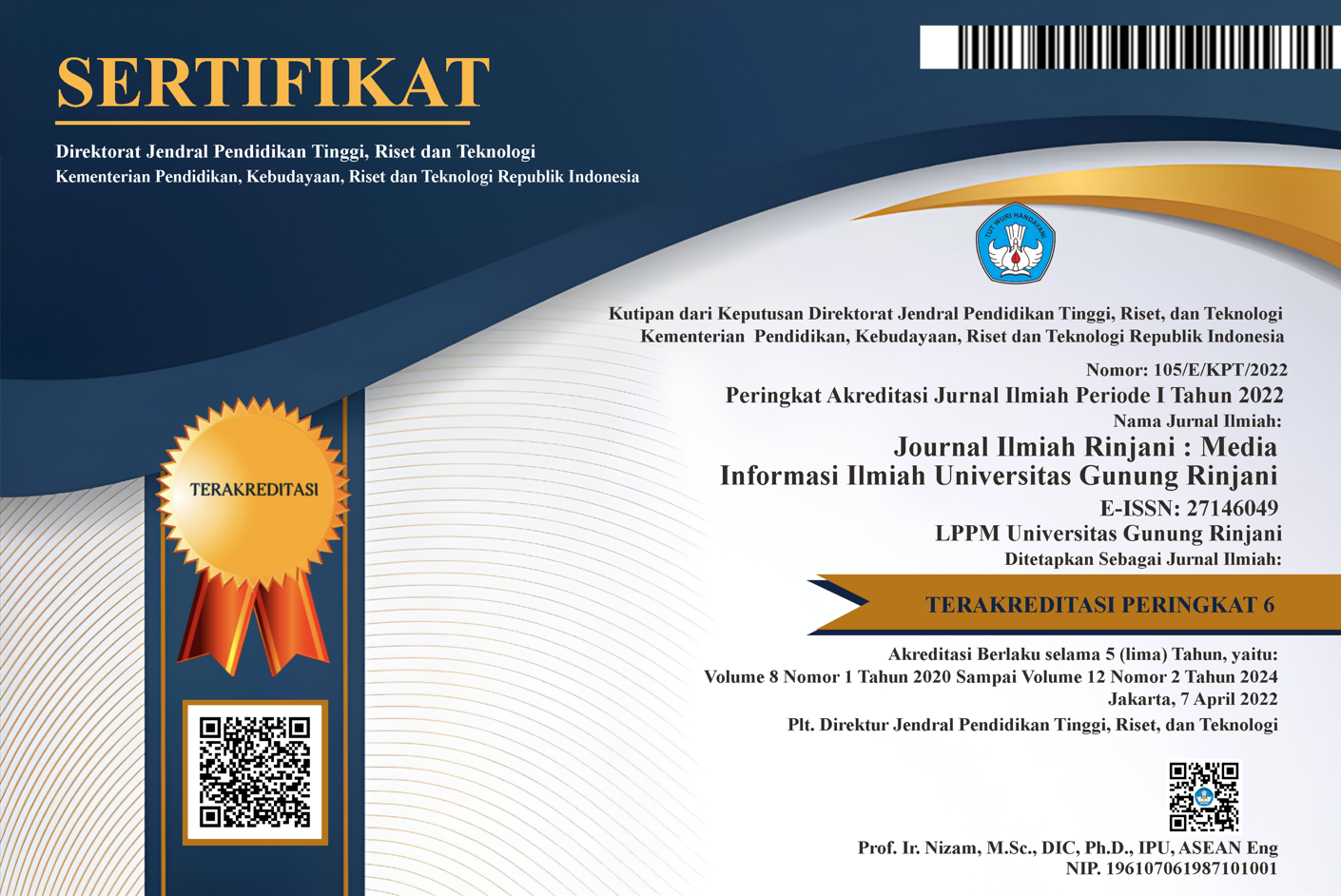INVESTIGATING TEACHER`S USE OF ICE BREAKING IN TEACHING SPEAKING
Keywords:
ce breaking, keterampilan berbicaraAbstract
Penelitian ini bertujuan untuk mengkaji jenis dan sejauh mana penggunaan strategi ice breaking oleh guru dalam pengajaran keterampilan berbicara. Metode yang digunakan adalah deskriptif kualitatif, dengan teknik pengumpulan data melalui wawancara dan observasi kelas. Data dikumpulkan dari semua sumber yang relevan, seperti wawancara, observasi, dan dokumen. Teknik analisis data kualitatif berfokus pada pemahaman yang mendalam terhadap fenomena yang sedang diteliti dengan mengidentifikasi tema, pola, atau kategori yang muncul dari data tersebut. Hasil penelitian menunjukkan bahwa guru menggunakan berbagai jenis aktivitas ice breaking, termasuk gerakan fisik seperti head shoulders, yel-yel, tepuk tangan, bernyanyi, dan permainan seperti Snowball dan Whispering serta peredam ketegangan seperti bercerita dan pertanyaan dadakan/pop-up question dan 95% guru memilih permaina. Aktivitas ini terbukti efektif dalam meningkatkan perhatian, motivasi, partisipasi, dan kepercayaan diri siswa dalam berbicara bahasa Inggris. Ice breaking paling sering digunakan di awal pelajaran untuk menarik perhatian siswa dan menciptakan suasana belajar yang menyenangkan. Guru menerapkan strategi ini baik secara terencana maupun spontan tergantung pada kondisi kelas. Secara keseluruhan, temuan ini menegaskan bahwa strategi ice breaking memainkan peran penting dalam menciptakan lingkungan belajar yang dinamis, interaktif, dan mendukung peningkatan keterampilan berbicara siswa.
Downloads
References
Ames, H., Glenton, C., & Lewin, S. (2019). Purposive sampling in a qualitative evidence synthesis: A worked example from a synthesis on parental perceptions of vaccination communication. BMC Medical Research Methodology, 19(1). https://doi.org/10.1186/s12874-019-0665-4
Anna Formisano, M., Effiong Umoh, D., Shehu Abdullahi, B., & Passafiume, M. (2024). Global Journal of Arts Humanity and Social Sciences Observational Methodologies in Education: Analysis of Interactions BY. Observational Methodologies in Education: Analysis of Interactions Article in Global Journal of Arts Humanities and Social Sciences. https://doi.org/10.5281/zenodo.13742720
Anne, •, Orison Carlile, J. •, & Stack, A. (2008). Approaches to Learning.
Author, T. /, & Saarinen, E. (2016). Kasvatustieteiden tiedekunta Tiivistelmä opinnäytetyöstä Faculty of Education Thesis abstract Intercultural Teacher Education “Everyone loves” atmosphere-Cornerstones of compassionate classroom atmosphere in a preparatory class.
Barness, A. J. (2011). Supporting student learning through scientific inquiry. https://scholarworks.uni.edu/grp/126
Berge, Z. L. (1995). The Role of the Online Instructor/Facilitator.
Cahya Sari, K., & Herawati, S. (2024). Exploring the Use of Game-based Ice-breaking Activities by English Teachers during the Teaching and Learning Process. Print) Journal of English Language and Education, 9, 2024. https://doi.org/10.31004/jele.v9i6.584
Colquitt, J. A., & Zapata-Phelan, C. P. (2007). Trends In Theory Building And Theory Testing: A Five-Decade Study Of The Academy Of Management JournalJOURNAL.
Cornell, J. Bharat. (1989). Sharing the joy of nature : nature activities for all ages. Dawn Publications.
Creswell, J. W. . (2003). Research design : qualitative, quantitative, and mixed methods approaches. Sage Publications.
Damyanti, M. W. (2024). Ice Breaking As A Trigger To Elevate Students Speaking Skills At Madrasah Aliyah Negeri 1 Pasuruan Thesis.
Darmayanti, R., Risnanda Arif, V., Soebagyo, R. I., Ali, M., & In’am, A. (2023). How can ice breaking’s “friends here, enemies there” increase the interest and enthusiasm of high school students for learning? KEYWORDS enthusiasm for learning ice breaking high school students interest in learning learning mathematics. AMCA JOURNAL OF SCIENCE AND TECHNOLOGY, 3(2), 53–60. https://doi.org/10.51773/ajst.v3i2/244
Deslauriers, L., McCarty, L. S., Miller, K., Callaghan, K., & Kestin, G. (2019). Measuring actual learning versus feeling of learning in response to being actively engaged in the classroom. Proceedings of the National Academy of Sciences of the United States of America, 116(39), 19251–19257. https://doi.org/10.1073/pnas.1821936116
DiCicco-Bloom, B., & Crabtree, B. F. (2006). The qualitative research interview. In Medical Education (Vol. 40, Issue 4, pp. 314–321). https://doi.org/10.1111/j.1365-2929.2006.02418.x
Douglas, J. E., Burgess, A. W., Burgess, A. G., & Ressler, R. K. (2006). Crime Classification Manual A Standard System For Investigating And Classifying Violent Crimes SECOND EDITION.
Fahsing, I. A. (2016). The Making of an Expert Detective Thinking and Deciding in Criminal Investigations. http://hdl.handle.net/2077/47515
Fredericksen, E., Pickett, A., Pelz, W., Swan, K., & Shea, P. (1999). Student Satisfaction and Perceived Learning with On-line Courses-Principles and Examples from the SUNY Learning Network. http://SLN.suny.edu/SLN
Furman Shaharabani, Y., & Yarden, A. (2019). Toward narrowing the theory–practice gap: characterizing evidence from in-service biology teachers’ questions asked during an academic course. International Journal of STEM Education, 6(1). https://doi.org/10.1186/s40594-019-0174-3
Gunawan, I. I., Darmayanti, R., In’am, A., Vedianty, A. S. A., & Vereshchaha, V. (2023). Clap-Breathe-Count: Using Ice-Breaking Ma-Te-Ma-Ti-Ka to Increase High School Students’ Learning Motivation. Delta-Phi: Jurnal PendidikanMatematika, 1(1), 51–57. https://doi.org/10.61650/dpjpm.v1i1.216
Hamrin, J. (2022). Degree Thesis (part 2) for Master of Arts in Primary Education-School Years 4-6 Icebreakers-an effective teaching strategy or a waste of time? A study of grade 4-6 English teachers’ use of Icebreakers and their perceived effect on students.
Henry P. Tappan. (1855). Elements_of_Logic.
Hoseini Shavoun, A., Hassan Adeli, S., & Ahmari-Tehran, H. (2024). Fostering Engagement: A Review of Icebreakers in Academic Environments. Academic Environments.MedEduBull,5(2),949–959. https://doi.org/10.22034/MEB.2024.495642.1105
Kaban Sendana, A., Kristen Indonesia Toraja Jl Nusantara No, U., Kabupaten Tana Toraja, M., & Selatan, S. (2011). The Ice Breaking Method Effectiveness On Students’ Enthusiasm In Learning English At SMPN 1 Saluputti.
Kallio, H., Pietilä, A. M., Johnson, M., & Kangasniemi, M. (2016). Systematic methodological review: developing a framework for a qualitative semi-structured interview guide. In Journal of Advanced Nursing (Vol. 72, Issue 12, pp. 2954–2965). Blackwell Publishing Ltd. https://doi.org/10.1111/jan.13031
Kamel, A. M., Omar, A., & Awad, A. (2019). The Effectiveness of Ice-breaker Strategy in Enhancing Motivation and Producing Conducive Classroom Atmosphere for the Tenth Graders in English Classes in Nablus City Schools from the Perspectives of Teachers and Students.
Khan, A. (2024). From Theory to Practice: Implementing Interdisciplinary Educational Strategies in K-12. In Frontiers in Interdisciplinary Educational Methodology (Vol. 01).
Khodijah, S. (2023). Implementation of Ice Breaking in Increasing Student’s Spirit of Learning. International Journal Of Education, Social Studies, And Management (IJESSM), 3(3), 7–13. https://doi.org/10.52121/ijessm.v3i3.185
Kholili, A. (2023). Investigating Factors Underlying Boredom in Learning English: The Case of Secondary School. Al-Lisan, 8(1), 13–32. https://doi.org/10.30603/al.v8i1.3185
Lamb, M. (2004). Integrative motivation in a globalizing world. System, 32(1), 3–19. https://doi.org/10.1016/j.system.2003.04.002
Lee, C. W. (2007). Is There a Place for Private Conversation in Public Dialogue? Comparing Stakeholder Assessments of Informal Communication in Collaborative Regional Planning 1. In AJS (Vol. 113).
Linda Darling-Hammond John Bransford. (n.d.). Preparing Teachers for a Changing World What Teachers Should Learn and Be Able to Do.
Madden, N. O., & Robinson, R. R. (2025). Using an innovative icebreaker in EFL classes to assess and enhance students’ speaking competence. International JournalofLanguageInstruction, 4(1), 1–19. https://doi.org/10.54855/ijli.25411
Mahmud, A. F., Yusup, A., Hi Saban, A., & Muhammadiyah Maluku Utara, U. (2023). The Implementation of Ice-Breaking Activities in English Classroom: A Descriptive Study of the Second-Grade Students’ Perceptions at SMA Al-Irsyad Kota Ternate. In Langua: Journal of Linguistics, Literature, and Language Education (Vol. 6, Issue 1).
McMullen, J., Kulinna, P., & Cothran, D. (2014). Physical activity opportunities during the school day: Classroom teachers’ perceptions of using activity breaks in the classroom. Journal of Teaching in Physical Education, 33(4), 511–527. https://doi.org/10.1123/jtpe.2014-0062
Muh Zaitun Ramadhan, B. (2020). The Use Of Ice Breakers By Pre-Service Teachers During Peer-Teaching Practicum In Private University Fulfillment Of The Requirements To Obtain The Sarjana Pendidikan Degree In English Language Education Department Of English Language Education Faculty Of Psychology And Sociocultural Sciences Islamic University Of Indonesia Yogyakarta 2020.
Muller, C., Sampson, R. J., & Winter, A. S. (2025). Environmental Inequality: The Social Causes and Consequences of Lead Exposure. https://doi.org/10.1146/annurev-soc-073117
Mulyadi, M., Nurdiansyah, E., Rachman, S. A., & Sadaruddin, S. (2023). The Effect Of Ice Breaking On Motivating Grade Iv Students To Learn Science. Lentera Pendidikan : Jurnal Ilmu Tarbiyah Dan Keguruan, 26(2), 256–269. https://doi.org/10.24252/lp.2023v26n2i3
Neetij, •, & Bikash Thapa, R. . (2015). A Study On Purposive Sampling Method In Research. http://study.com/academy/lesson/what-is-sampling-in-research-definition-methods-importance.html,
NISRINA VITA CAHYARANI. (2024). The Implementation Of Ice Breaker Technique To Improve Students’ Speaking Skills Of Tenth Grade Students At Sman 10 Bandar Lampung.
Njabulo Ncube, W. (2015). Procedures For Searching Evidence In The Investigation Of Computer-Related Crime In Bulawayo, Zimbabwe By Njabulo Ncube Core View Metadata, Citation And Similar Papers At Core.Ac.Uk Provided By Unisa Institutional Repository.
Noratul Emi1, F. (2024). The Efficacy Of Ice-Breaking Activities In Enhancing Students’ Motivation For English Language Acquisition.
Panggua, S., Pd, S., & Pd, M. (2016). The Effectiveness of Ice-Breaker Activity to Improve Students’ Speaking Skill of The Third Semester Students of English Department Students of FKIP UKI Toraja.
Praetorius, A. K., & Charalambous, C. Y. (2023). Theorizing Teaching: Current Status and Open Issues. In Theorizing Teaching: Current Status and Open Issues. Springer International Publishing. https://doi.org/10.1007/978-3-031-25613-4
Reeve, J. (2024). S&Th Edition Understanding Motivation And Emotion.
Reffalleo, A. (2024). INVESTIGATING THE USE OF ICEBREAKER ACTIVITY AND ITS INFLUENCE ON STUDENTS’ SELF-CONFIDENCE IN SPEAKING (An Exploratory Sequential Research on Students of SMP IT Rabbi Radhiyya) AN UNDERGRADUATE THESIS.
Stuart H. James and Jon J. Nordby. (2001). An Introduction to Scientific and InvestigativeTechniques. Third Edition.
Urnila, S., Wulandari, S., & Prasongko, A. (2024). Teachers’ perceptions on the use of digital games to support young learner vocabulary learning. Child Education Journal, 2, 99–110. https://doi.org/10.33086/cej.v6i2.6021
Wang, Y.-H. (2010). Using Communicative Language Games in Teaching and Learning English in Taiwanese Primary Schools. In Journal of Engineering Technology and Education (Vol. 7, Issue 1).
Yuwono, F. A., Untari, R. S., Suminar, L., Izzul, R., & Syifa, M. (2024). The Importance Of Doing An Ice-Breaking Before Core Learning Activities.
ZIOUD Fatima Zahra. (2021). The Use Of Gamification In Teaching ENGLISH LANGUAGE: Its Effectiveness On Raising Students’ Motivation And Engagement In Classrooms The Case Of Fourth-Year Middle School Students At Zerari Mohamed Saleh-Biskra.
Zoltan Dornyei. (2009). Motivation_in_second_and_foreign_languag.
Zoltán Dörnyei and István Ottó. (1998). Motivation in action: A process model of L2 motivation 1 Zoltán Dörnyei and István Ottó.












